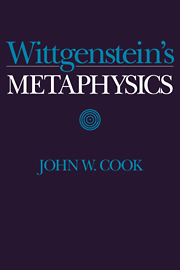Book contents
- Frontmatter
- Contents
- Preface
- List of Abbreviations
- Introduction
- Part I From Idealism to Pure Realism
- 1 Wittgenstein's Philosophical Beginnings
- 2 Neutral Monism
- 3 The ‘Objects’ of the Tractatus
- 4 The Essence of the World Can Be Shown But Not Said
- 5 What the Solipsist Means is Quite Correct
- 6 Pure Realism and The Elimination of Private Objects
- Part II The Metaphysics of Wittgenstein's Later Philosophy
- Part III Causation and Science in a Phenomenal World
- Part IV Logical Possibilities and the Possibility of Knowledge
- Part V The Past, Memory, and The Private Language Argument
- Name Index
- Subject Index
3 - The ‘Objects’ of the Tractatus
Published online by Cambridge University Press: 05 November 2011
- Frontmatter
- Contents
- Preface
- List of Abbreviations
- Introduction
- Part I From Idealism to Pure Realism
- 1 Wittgenstein's Philosophical Beginnings
- 2 Neutral Monism
- 3 The ‘Objects’ of the Tractatus
- 4 The Essence of the World Can Be Shown But Not Said
- 5 What the Solipsist Means is Quite Correct
- 6 Pure Realism and The Elimination of Private Objects
- Part II The Metaphysics of Wittgenstein's Later Philosophy
- Part III Causation and Science in a Phenomenal World
- Part IV Logical Possibilities and the Possibility of Knowledge
- Part V The Past, Memory, and The Private Language Argument
- Name Index
- Subject Index
Summary
In the Tractatus the term “object” plays an important, yet rather obscure, role. It is important because it is said that “objects make up the substance of the world” (TLP, 2.021); they are what the unanalyzable words of language stand for (TLP, 3.203). Yet Wittgenstein does not make as clear as he might have what sort of thing he is thinking of when he speaks of objects. He does say that they must be “simple” (TLP, 2.02), meaning that they do not have nameable parts. He also says: “Objects, the unalterable, and the subsistent are one and the same” (TLP, 2.027). But if Wittgenstein had in mind that these objects belong to some particular metaphysical category, he failed to make this perfectly clear in the Tractatus. He does say that “empirical reality is limited by the totality of objects” (TLP, 5.5561). This and other passages (2.0131, 2.0251, and 4.123) suggest that he thought of objects as being phenomenal entities. That this was his actual view is borne out by much that he says elsewhere. Most significant, perhaps, is his remark in his pre-Tractatus notebooks that “all experience is the world” (NB, p. 89). Since objects “make up the substance of the world” (2.021), it follows that objects are elements of experience (visual, tactile, etc.). When he explained the Tractatus to Frank Ramsey in 1923 he said that “… to be given in experience is [the] formal property [that's required] to be a genuine entity.”
- Type
- Chapter
- Information
- Wittgenstein's Metaphysics , pp. 31 - 44Publisher: Cambridge University PressPrint publication year: 1994



